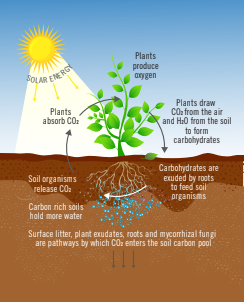Carbon Farm Planning
Regenerative Farming Practices and Native Plant Ecosystems: Crucial Tools for Climate Resilience
"The rate of warming since 1982 is more than three times as fast: 0.36° F (0.20° C) per decade."National Oceanic and Atmospheric Administration, Climate.gov
What is Carbon Farming? Synonymous with regenerative agriculture, carbon farming involves the implementation of practices that are known to improve the rate at which carbon dioxide, a primary green house gas, is removed from the atmosphere and converted to soil organic matter and plant biomass. Like regenerative agriculture, carbon farming is also focused on the revitalization of soil health and creating a healthy ecosystem on your farm.
Agricultural land stewards play a unique and crucial role in the solution to fight climate change. Modern standard agricultural practices such as heavy tillage, mono-croppping, and prolific pesticide and fertilizer use have contributed to global warming with an excess of greenhouse gas emissions and depletion of our soils. Carbon Farming offers strategies to reverse this trend and restore balance by capturing carbon back into the soil and keeping it there.
Carbon Farming practices are proven to increase soil health and fertility, crop production, water retention and water infiltration.The following conservation practices common to carbon farming will increase your operation's resilience to extreme weather and drought. These practices include, but are not limited to:
- compost
- mulching
- native plant conservation cover
- planting cover crops
- hedgerows
- windbreaks
Armed with a Carbon Farm Plan that includes these conservation practices, farmers can be the climate heroes that we need today!
Interested in having a carbon farm plan? Farm site visits are currently on pause and will resume on September 22nd. You can still sign up to get your name on the list in the meantime! Fill out our intake form.
Eligibility Criteria:
- Have a farm, ranch or other working lands within our district. Visit this interactive map to view which district you are in.
- You use pesticide free management practices, or are willing to reduce or discontinue use of pesticides and learn integrated pest management practices
- At least one of the practices in your Carbon Farm Plan must include native plants, including native milkweeds for monarchs.
Mission RCD is one of 42 RCDs and 5 partners awarded funding to expand monarch and pollinator habitat on public and working lands and to assist landowners in the implementation of carbon farm practices that create habitat and sequester carbon. The funds for this project come from the Wildlife Conservation Board via the CARCD Climate Habitat Block Grant. This block grant is managed and distributed by the California Association of Resource Conservation Districts (CARCD).


